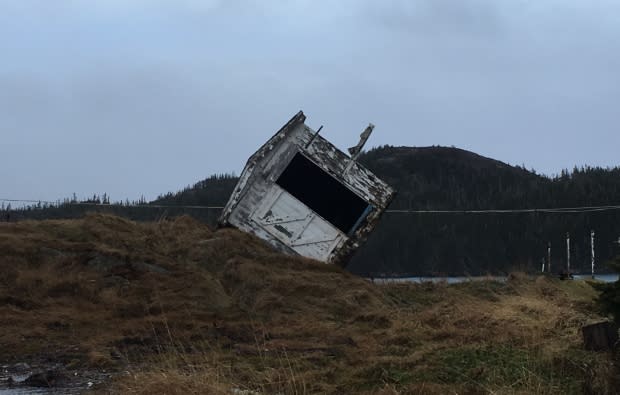Think N.L. is getting windier? Think again
The fall of 2018 might be remembered as a season that saw intense winds slam Newfoundland over and over, ripping up patios, shingles and powerlines as visible wreckage of changing weather patterns — but it turns out, that isn't exactly so.
Data compiled by Climate Services Canada and Environment Canada for the CBC dispels the water cooler conversations of how much windier the province is getting overall, a topic that has seeped into small talk like a cold breeze into a poorly ventilated house.
"With the winds coming up in the past little while, I think people are maybe looking at it like, 'seems like it's getting windier,' when in reality, it's been really up and down over the past few decades," said David Neil, a meteorologist with the Gander weather office of Environment Canada. "There hasn't been any trend we can hang our hats on."

The one constant? Inconsistency
Basically, blame our short memories.
Neil, who looked at data from September through November 2018 and then peeked at historical data for the past 60 years or so for the same time frame, noticed a recent lull that may have, well, lulled us into a false sense of weather trends.
"Really, the past few years or so, winds have been quite strong, But it's more in relation to a period of roughly a decade or so ago, when wind speeds were actually relatively lower, or calmer," he said.
"In relation to that period where it was a little bit calmer, roughly 10 or so years ago before that we saw winds that were quite similar to what we're seeing today."

Those strong winds blew through Newfoundland and Labrador in the late '80s and early '90s, setting records: Bonavista made history Jan. 11, 1991, for both its maximum hourly winds, at 130 km/h, and its maximum gust, at 169 km/h.
Port aux Basques made its maximum hourly wind record on Feb. 13, 1995, clocking in at 120 km/h. Cartwright hit 117 km/h sustained winds on Jan. 20, 1990, and made its record of 141 km/h gusts the same day.
Besides that record-setting/patio-wrecking period, the history of provincial wind patterns has "just been up and down," Neil said.
A November to remember
If you're reading this and grumbling about all those times you have recently rescued your garbage can from two blocks away, you're not totally crazy; the snapshot of data from September through November 2018 does show November to be a standout month for wind speeds.
Port aux Basques, Englee, Rocky Harbour, Stephenville and Twillingate all set November records for hourly wind speeds. St. John's was 39 per cent windier than normal, and Bonavista endured 23 of November's 30 days with sustained winds greater than 50 km/h.
Those numbers had real life consequences: think of the roof that sheared off a restaurant in Port aux Basques, or the 44 times Marine Atlantic ferries stayed tied up in port (November 2017 saw only 22 cancelled sailings.)
Perhaps most consequential at all was the offshore oil spill on Nov. 16, when 250,000 litres of oil, water and gas flowed from Husky Energy's SeaRose vessel into the North Atlantic amid high winds and rough seas.
Don't worry, it's still windy
But one thing to remember: this chat of wind speeds is relative.
Newfoundland and Labrador is still a very windy spot — those tuckamores didn't twist themselves, and our Environment Canada threshold to issue wind warnings is higher than the rest of Atlantic Canada.
Bonavista may not have set any records during November, but that doesn't mean it wasn't blowing a pretty impressive gale, experiencing wind, at its strongest, at an impressive 108 km/h — that's sustained wind, not a simple gust.
"It is a windy place that we live, that's for sure, " Neil confirmed, dashing the hopes of would-be convertible owners everywhere.
"In order to set a record, it has to be something quite extreme."

While climate change is often mentioned when talking about changing weather — one of its hallmarks being more frequent and severe weather events — it's not clear yet if that's a culprit behind our most recent storms.
"It's very hard to ascertain that," said Neil, pointing to the regular ups and downs in the last 60 years of data.
"Just looking at the way the trend is, it's very difficult to say at this point."
Read more from CBC Newfoundland and Labrador

